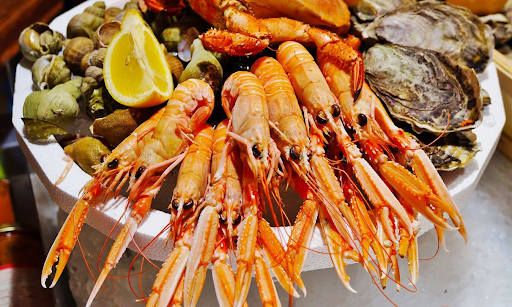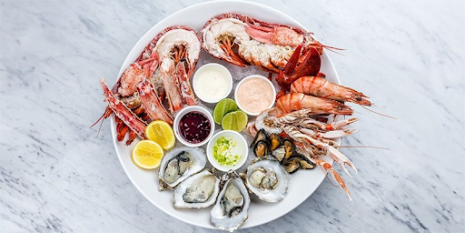
How Do You Create & Serve A French Seafood Platter
Seafood has always played a crucial role in French cuisine. France has a strong relationship with the sea, from rich seafood soups to wonderfully delicate fish. It is no surprise that a Plateau de fruits de mer—a French seafood platter—is one of the most popular dishes across the country, particularly in coastal towns or cities.
Today, we’re going to show you how to create a traditional French seafood platter at home – and how to serve it. You’ll find the ingredients to put the dish together, plus some key pointers on how to serve it the “French” way.
What To Include On A Fruit De Mer
Like most French food staples, the brilliance of a Plateau fruits de mer lies in its simplicity. There’s no need to overcomplicate things here—the dish is comprised of three main elements: seafood, a sauce, and some garnishes. Serve with a side, and you have a hearty main course to enjoy at lunchtime.
What Seafood To Include
Generally speaking, your seafood platter needs to include four main types of seafood. Regional differences can exist across France, but most culinary experts agree that these are the four ingredients you need:
Lobster
We can’t talk about French seafood without starting with lobster. The rich meatiness of lobster adds something unique to the platter and provides a delightful texture and butteriness. It’s best served split and grilled or boiled, depending on the preference of your guests.
Crab
Adding crab to your seafood platter helps elevate its appearance. The French traditionally serve it as crab legs or claws, so there is a splash of deep orange on the plate. Cracking open the crab legs or claws and enjoying the succulent meat inside becomes a big part of the experience of eating the platter.
Moules
Moules – or mussels – are a must for your platter. They provide an welcomed saltiness to the dish, and many French restaurants will fish them out hours before they’re served. It may not be possible to do this at home but you should get your mussels from a fishmonger rather than a supermarket as they’re of a higher quality. After cooking, you should shuck them open and serve the mussels without their shells to create more room on the dish!
Prawns
It’s best to serve freshly cooked prawns with the shells still on for better flavourings. You can cook them however you like, though many French chefs have taken to grilling the prawns so you get a new type of flavour on the platter. We love this idea as it helps to cut through some of the fishiness.
What Sauce To Use
The sauce doesn’t need to be fancy. It just needs to be simple so that it can let the delicious seafood shine through. You can serve it with:
Mayonnaise
A traditional, homemade mayonnaise pairs excellently with all the seafood on your platter. There’s a richness from the eggs and a bit of tartness from some lemon to cut through the saltiness from the fresh seafood ingredients. Adding a touch of mustard to your mayo gives it an even deeper flavour – and it’s best served in small pots or ramekins either on the platter or to the side.
What Garnishes To Use
Don’t go crazy with the garnishes, as very few are needed. It’s all about adding little things that bring the platter together and marry all the flavour profiles.
Lemon Wedges
Lemon and seafood complement one another as the acidity and salt balance each other out. It gives your palate a real treat and brings out all the delightful flavours.
Parsley Sprigs
The freshness of parsley enhances the delicate flavour of seafood and serves as a brilliant garnish. It almost makes everything taste juicier and fresher, too, while also adding a bit of greenery to the plate.
Cherry Tomatoes
Slicing some cherry tomatoes in half and adding them to your platter will a bit of vibrancy and another layer of acidity to complement the salty nature of the seafood. Grow them if you can, or get some high-quality ones from a local market.
What Sides To Serve With A French Seafood Platter
When served as a starter, you don’t need to add sides to your seafood platter. However, if it’s a main course, you can serve it alongside either of the following:
Salad Nicoise
This is a beautifully traditional French salad composed of tuna, soft-boiled eggs, crunchy lettuce, potatoes and cherry tomatoes. It works well as a side here because it gives a completely different flavour profile to offset all the seafood you just ate.
Paella Rice
While a quintessentially Spanish dish, paella makes a lovely side for your French seafood platter. Paella is traditionally served with seafood as the saffron and aromatic flavours work perfectly alongside fresh seafood tastes.
How To Serve A French Seafood Platter
When serving your French seafood platter, follow one golden rule: it needs to be served cold and on ice!
Why? Because the ice helps regulate the temperature and keeps the seafood fresh. Without it, you run the risk of the ingredients getting warm and potentially tasting bad. Having a bed of ice below makes everything taste fresher, so you get a better jolt of flavours.
Some people wonder how to decorate a French seafood platter, but the answer is to keep it simple. Let the ingredients do all the work, and style your platter with the bigger things around the outside and the smaller seafood in the middle. Use little pots filled with mayo to break up the seafood, and place some lemon wedges here and there for a splash of colour. Finish with a sprinkling of bright green parsley and serve with your sides on separate plates.
Bon Appetit!
Remember, a traditional French seafood platter is all about using simple ingredients and celebrating their tastes. You don’t need to overcomplicate things – and the secret lies in getting quality French ingredients wherever possible. If you’re looking for a place to buy luxury French food items, then you’re in the perfect place. Check out the rest of our website to see our offerings and place orders online right away.

